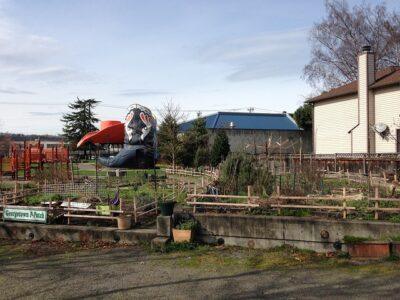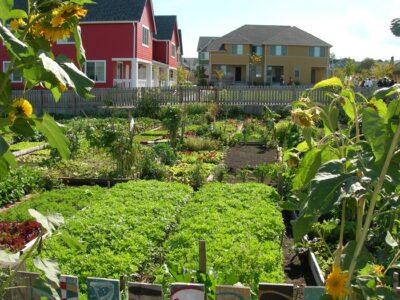|
Listen To The Article
|
There are a lot of obstacles to overcome when transitioning to a more self-sufficient life. Unfortunately, sometimes the area you live in is the biggest roadblock, and moving isn’t an option. When it comes to growing your own food, you might find yourself stuck in a difficult position.
There are three major disadvantages to starting a large garden in an urban atmosphere:
- Lack of space
- City permitting requirements
- Social issues with your neighborhood
The most obvious disadvantage is the lack of space. Most city lots have fairly small backyards and tiny front yards. You don’t have much space to work with and even may have zero space. People living in apartments are only able to grow their own food in a container on their balcony.
Another issue has to do with city permits. Some cities have a mentality of pretty much wanting to ban their inhabitants [2] from growing any garden large enough for food production. If you need to build tool sheds or greenhouses, you may also stumble across permitting issues depending on where you live.
And for some people – say, your neighbors, working gardens certainly aren’t pleasing to the eye. Though a neighbor doesn’t have the power to tell you what you can and can’t do with your property, the added conflict can be very stressful.
Your Best Source For Non-GMO Garden Seeds Is Right Here! [3]
If any of these issues are affecting you and you still want to garden, then don’t give up.
Starting a Community Garden
Community gardens are one option. These are simply gardens on private or public land that are open to the public or to a specific neighborhood. Typically, these gardens rely solely on volunteer efforts, and the community involved shares what the garden produces.
There are a couple of different advantages to starting a community garden:
- It’s a great way to get to know like-minded community members and neighbors.
- It’s an excellent learning opportunity if you have veteran gardeners helping.
- You have some flexibility on tending to the garden (i.e. going on vacation).
- Expenses are shared by community members and/or by the city.
Unfortunately, there are some disadvantages as well. You may clash with community members or have a difficult time finding people who want to be involved. If you are trying to run the project on private land, it may cost you more out of pocket than growing the food yourself. Another possible problem could be thieves or community members who take too much food.
If you are a determined individual with a need for social setting and helping others, starting a community garden is often well worth the effort.
Getting Started with a Community Garden
The technicalities and legalities of starting a community garden are a vast subject since it depends greatly on your location. Though much personal research is required, the following steps are an excellent foundation for the process of creating a community garden.
1. Organize a Gathering of All People Interested or Required to Be Involved
Put out flyers and make calls around your neighborhood. Contact local gardening associations and other organizations interested in assisting. You may also want to invite members of the city board to come to the meeting.
2. Create a Committee Panel for the Garden
Select a few reliable community members as an organization panel for the garden. These members don’t necessarily have to be knowledgeable in gardening but should be responsible individuals with a passion for starting the garden.
3. Figure Out What Resources the Community Offers
Create a list of skills and resources community members bring to the table. You will also want to find out if local organizations or the city provide any resources for community gardens as well.
4. Determine How the Garden Will Be Funded
There are two main options here: private funding or being sponsored. If you have many people interested in the community garden, you can privately fund by charging a membership fee.
The Cheap Way To Re-mineralize Your Soil [5]
If that isn’t the case or you just want to lower the costs of the membership fees, you can also ask local businesses, schools, churches, etc., if they would be interested in sponsoring the garden.
5. Contact the City to Find Available Space for the Garden
You should include the community garden panel in this step. After finding a couple locations to choose from, it would be a good idea to call another meeting of all interested community members to make a decision.
6. Gather Volunteers for Preparing the Land
Once the plot is chosen, it’s time to prepare the land. This step should also involve all community members who are interested, since you’ll be determining where beds will be placed as well as recreational areas such as benches for sitting and relaxing.
7. Agree on the Rules of the Garden
After the garden is ready to be planted you will want to call another meeting to make a list of what vegetables, fruits and ornamentals everyone would like. This meeting should also include the creation of the community garden’s rules. Don’t skip this rule list. It may seem silly for a small, close-knit community, but it will help prevent or resolve conflicts in the future.
8. Create Volunteer Schedules and Start Planting
Volunteer schedules don’t have to be strict, but they help ensure the garden gets the care it needs. These schedules also ensure that all volunteers spend close to equal amounts of time helping out. This is another way to proactively avoid conflict. Once that is squared away, it’s time to start planting!
There are many different resources for starting community gardens online. One very valuable resource is the American Community Gardening Association [7].
Growing your own food is the foundation of self-sufficiency. Even if you aren’t in your ideal situation, there is always some way you can grow a portion of your own food, even if it’s a couple of tomato plants on your porch.
Have you considered starting a community garden? Maybe you currently rent a small bit of land for gardening purposes? Please share your helpful stories and ideas in the section below.
Every Year Gardeners Make This Avoidable Mistake — But You Don’t Have To. Read More Here. [8]


